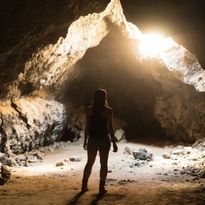In Mosa Mack’s Rock Cycle unit, students are led through a progression of three inquiry lessons that focus on the properties of igneous, sedimentary and metamorphic rocks and the forces responsible for creating them. Forces include heat, pressure, cooling, weathering and erosion.
- Lesson 1
Solve: Amazing Rock Formations + Treasure Hunt Mystery
Choose to solve a live video mystery exploring a variety of amazing rock formations and how they formed, or solve an animated mystery to discover properties of igneous, sedimentary, and metamorphic rocks and the forces responsible for creating them. (Live Solve: 45-90 minutes; Animated Solve: 45-70 minutes).
- Lesson 2
Make: Journey through the Rock Cycle
Students journey through the rock cycle by using crayons to model the properties and formation of sedimentary, metamorphic, and igneous rock. (120 mins)
- Lesson 2
Make Extension: Use evidence from rock strata to organize Earth’s history
Students complete three activities to construct an explanation, based on evidence from rock strata, for how the geologic time scale is used to organize Earth’s history. (140 mins)
- Lesson 3
Engineer: Engineer a solution to protect a monument from weathering and erosion
Students develop and design a solution to prevent or mitigate the impact of weathering and erosion on a famous monument made of rock. (150 mins)
- Next Generation Science Standards
- 4-ESS2-1
- Make observations and/or measurements to provide evidence of the effects of weathering or the rate of erosion by water, ice, wind, or vegetation. [Clarification Statement: Examples of variables to test could include angle of slope in the downhill movement of water, amount of vegetation, speed of wind, relative rate of deposition, cycles of freezing and thawing of water, cycles of heating and cooling, and volume of water flow.] [Assessment Boundary: Assessment is limited to a single form of weathering or erosion.]
- 4-ESS2-2
- Analyze and interpret data from maps to describe patterns of Earth’s features. [Clarification Statement: Maps can include topographic maps of Earth’s land and ocean floor, as well as maps of the locations of mountains, continental boundaries, volcanoes, and earthquakes.]
- MS-ESS1-4
- Construct a scientific explanation based on evidence from rock strata for how the geologic time scale is used to organize Earth's 4.6 billion year old history. [Clarification Statement: Emphasis is on how analyses of rock formations and the fossils they contain are used to establish relative ages of major events in Earth’s history. Examples of Earth’s major events could range from being very recent (such as the last Ice Age or the earliest fossils of homo sapiens) to very old (such as the formation of Earth or the earliest evidence of life). Examples can include the formation of mountain chains and ocean basins, the evolution or extinction of particular living organisms, or significant volcanic eruptions.] [Assessment Boundary: Assessment does not include recalling the names of specific periods or epochs and events within them.]
- MS-ESS2-1
- Develop a model to describe the cycling of Earth's materials and the flow of energy that drives this process. [Clarification Statement: Emphasis is on the processes of melting, crystallization, weathering, deformation, and sedimentation, which act together to form minerals and rocks through the cycling of Earth’s materials.] [Assessment Boundary: Assessment does not include the identification and naming of minerals.]
- MS-ESS2-2
- Construct an explanation based on evidence for how geoscience processes have changed Earth's surface at varying time and spatial scales. [Clarification Statement: Emphasis is on how processes change Earth’s surface at time and spatial scales that can be large (such as slow plate motions or the uplift of large mountain ranges) or small (such as rapid landslides or microscopic geochemical reactions), and how many geoscience processes (such as earthquakes, volcanoes, and meteor impacts) usually behave gradually but are punctuated by catastrophic events. Examples of geoscience processes include surface weathering and deposition by the movements of water, ice, and wind. Emphasis is on geoscience processes that shape local geographic features, where appropriate.]
- Inquiry Scale
- Each lesson in the unit has an Inquiry Scale that provides directions on how to implement the lesson at the level that works best for you and your students.
- “Level 1” is the most teacher-driven, and recommended for students in 4th-5th grades. “Level 4” is the most student-driven, and recommended for students in 7th-8th grades.
- For differentiation within the same grade or class, use different inquiry levels for different groups of students who may require additional support or an extra challenge.
- Common Misconceptions
- Students may think that rocks can only move through the rock cycle in one direction. Emphasize that each type of rock can become any other type of rock depending on the forces that act on it. Even an igneous rock can remelt and become another type of igneous rock.
- Students may assume that weathering and erosion are the same force. Emphasize to students that weathering is the breaking down of rock while erosion is the process of transporting the broken-down sediments.
- Students may initially believe that all rocks are the same. Emphasize that there are different types of rocks that have different properties.
- Students may believe that all rocks of the same type are identical. Emphasize that even within rock types, rocks can look different. This is a result of the circumstances led to their formation.
- Vocabulary
- Igneous Rock
- Sedimentary Rock
- Metamorphic Rock
- Sediment
- Erosion
- Weathering
- Content Expert
- Eric Pyle, PhD
Professor, Department of Geology & Environmental Science
James Madison University
- Leveled Reading
* To give our users the most comprehensive science resource, Mosa Mack is piloting a partnership with RocketLit, a provider of leveled science articles.
- Break Something, Build Something Else
You might think that erosion and weathering are always ruining and breaking things down, but if it weren't for these two, there would be no beaches. How sad would that be? Deconstruction helps the earth to constructs new things through deposition, like sedimentary rock!
RocketLit serves tailored Science reading to every student in your classroom at their independent reading level.
- Erosion
Sometimes, we need to say goodbye to our rock friends. In this article, the process of erosion is discussed, along with the resulting sediment, deposit and scree that build up as a by product of all of the rocks making their way towards their beachfront property.
RocketLit serves tailored Science reading to every student in your classroom at their independent reading level.
- The Force it Takes to Break Rock
When we think of breaking rock, typically the image that comes to mind is some huge force being applied to smash a rock into bits. That's definitely an accurate (and violent) example of mechanical weathering. In addition, salt and ice also sneak into cracks of rocks to exert massive amounts of force and break rocks apart.
RocketLit serves tailored Science reading to every student in your classroom at their independent reading level.
- Breaking Rock Without Force
You don't need to be a superhero to break rock. It turns out that a lot of the rock around us is broken apart by the combined effects of water and the gases we breathe in and out.
RocketLit serves tailored Science reading to every student in your classroom at their independent reading level.
- Break it and Move it.
The landscape around us is shaped by wind and water, but how? This article discusses the basics of erosion and weathering as well as a brief overview of some of the differences between the weathering of wind and water.
RocketLit serves tailored Science reading to every student in your classroom at their independent reading level.




